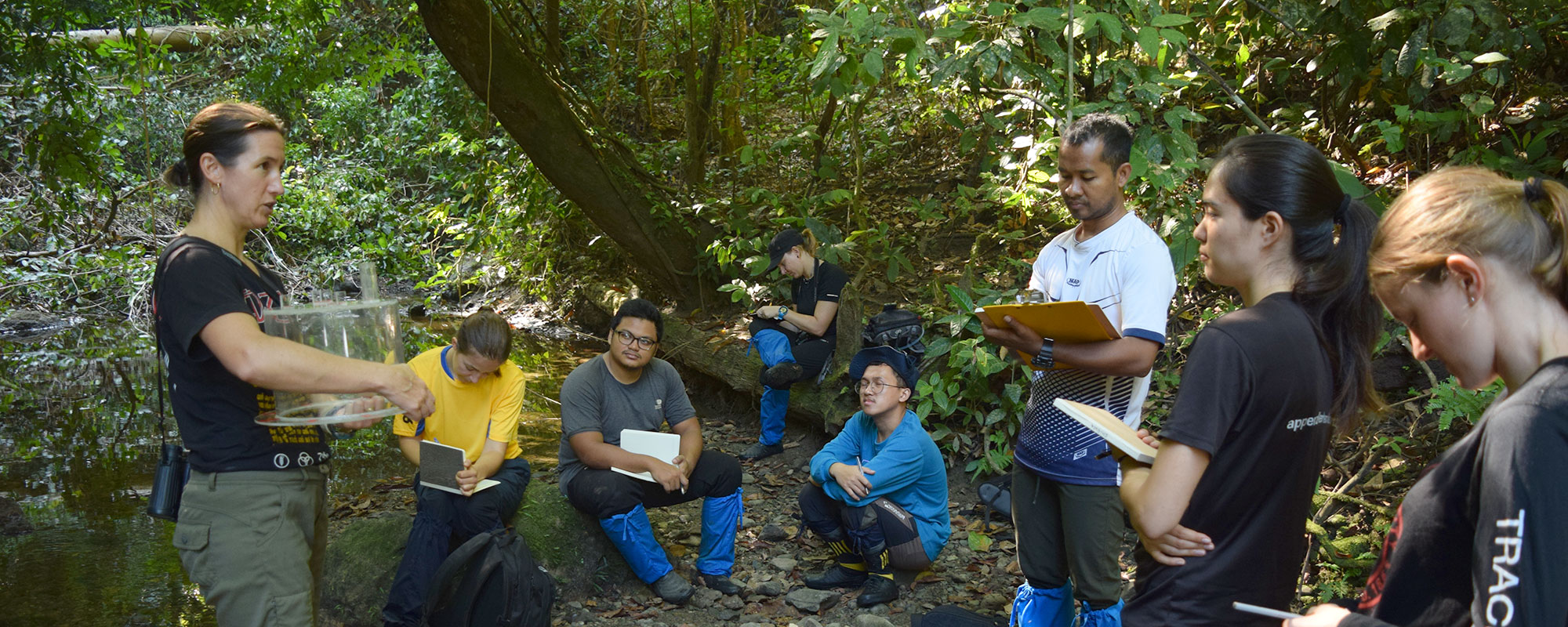Jennifer Sheridan always knew she wanted to work with animals. But it wasn’t until she was standing in a pond in northeast Illinois, up to her waist in water, that she knew those animals would be amphibians.
Sheridan was an undergraduate at the University of Chicago at the time, and she’d signed on as a field assistant with a graduate student who was researching amphibians in the forest preserves surrounding the city. Each day, they would set small traps that anglers use to catch bait minnows to sample the biodiversity found just a few miles away from the bustle of the Windy City.
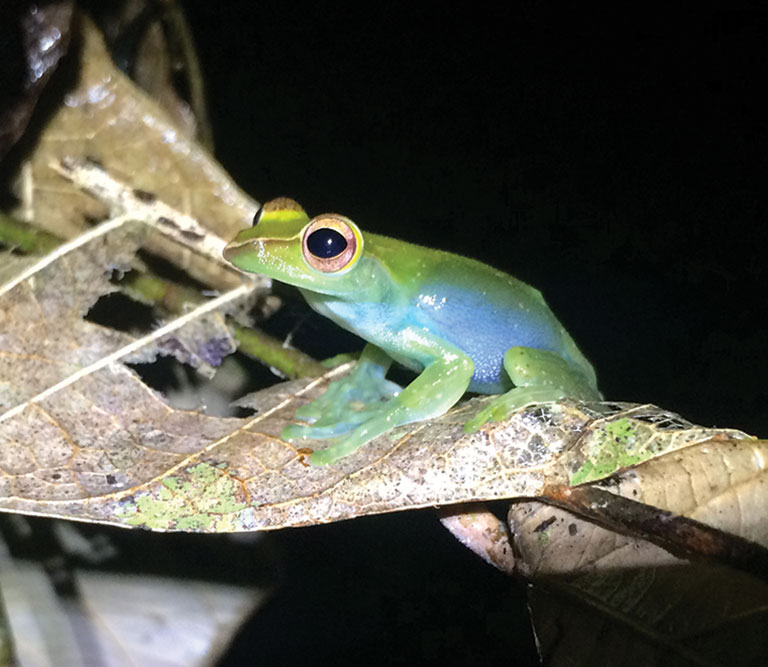
A jade tree frog (Rhacophorus dulitensis) photographed by Sheridan in the field.
“Then we’d go back the next day and open them up, and they were just full of giant tadpoles and blue spotted salamanders,” says Sheridan. “And I remember thinking, ‘I can’t believe I’m getting paid to play with animals.’”
The experience was a turning point for the budding ecologist. As a kid growing up in Detroit, Sheridan says she didn’t know there were career paths for people like her—those interested in animals and being outside. In fact, the only person she’d been exposed to who had a job even remotely similar was the famous zoologist Dian Fossey.
“So, for a long time as a little kid, I thought I would be an anthropologist, because I thought that meant I could study gorillas,” says Sheridan, noting Fossey’s pioneering research.
Fortunately, a number of experiences like the one in the Illinois pond started to open up her view of the world. There was a particularly engaging science teacher in high school and an enlightening ecology course in college. But the event that truly crystallized her trajectory was a six-month appointment in Malaysian Borneo before going on to complete a master’s degree at the University of Miami and a doctorate at the University of California, San Diego.
“That just really did it for me. I’d always wanted to see a rainforest. And it was even more amazing than I thought it could be,” says Sheridan. “If you come from the Midwest, I just don’t think as a kid you can fathom what that kind of biodiversity looks like.”
Malaysian Borneo is home to a litany of creatures most humans will only see in a museum or zoo. The rainforest canopy hoots and hollers with gibbons, while bug-eyed tarsiers can be found clutching at branches with their ET-like fingers. Sun bears plod through the jungle below, along with pygmy elephants, clouded leopards, and bearded pigs. Countless birds, butterflies, and even Wallace’s flying frogs glide between the treetops, while 61 species of land snail creep through the leaf litter underfoot. It’s an ecologist’s paradise.
“I remember being there and thinking, ‘I get it now,’” says Sheridan.
As the new assistant curator of amphibians and reptiles at Carnegie Museum of Natural History, her first museum post, Sheridan is now making it her mission to help others get it, too.
Frog in hand
Sheridan has been back to the jungle many times, where she focuses her studies on frogs—the perfect gateway animals, she says, for those interested in the sciences.
“If you’re studying gorillas, maybe you can take people out to see gorillas, but you’re not going to be handling them,” she says. “But you can get someone to hold a frog in their hand, and that physical connection I think is really important for making a strong emotional or mental connection with wildlife and conservation.”
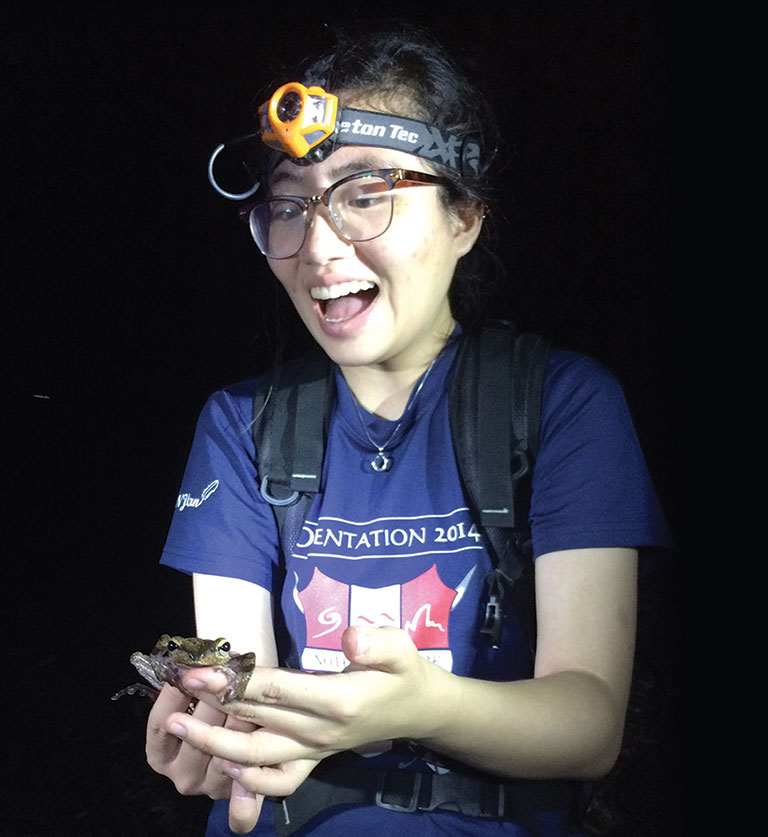
Ignacius Tay, a Yale-NUS college student, holds a tree frog (Polypedates) in Borneo.
“It’s important for me to keep providing these kinds of experiences because I know from my own experience how transformative they can be.”
– Jennifer Sheridan, assistant curator of amphibians and reptiles at Carnegie Museum of Natural History
Frogs also aren’t big biters, unlike the green-rumped parrotlets and other birds Sheridan studied for a brief time in Venezuela. (“I loved being in Venezuela, and I loved that I had that chance. But I hated working on birds,” she laughs.)
What’s more, frogs and other amphibians are widespread across planet Earth. Even though we tend to think of the animals as being tied to wetlands, amphibians live on every continent except Antarctica, and they inhabit nearly every biome—even deserts.
“There are species that burrow under the sand and create a cocoon for themselves,” says Sheridan. “And then when the rains come to the desert, they’ll come out and breed and do their thing.”
Believe it or not, there are even frogs found above the Arctic Circle.
“There are species that effectively have antifreeze in their blood,” says Sheridan. “It basically prevents them from freezing solid. And then they thaw in the spring, and they’re happy as a clam!”
But even as frogs are resilient and diverse, they are also highly vulnerable to environmental changes.
Amphibians are bioindicators, which means that when things go wrong in the environment—like a chemical spill, say—amphibians are some of the first species to feel the effects. This is due in part to the way these animals can exchange gases through their skin as a supplement to normal breathing. Some frogs and salamanders mastered this trick so well, evolution completely removed their lungs. Having permeable skin also makes the animals particularly susceptible to toxins and pathogens.
A case in point: frog populations all over the globe have been crashing as a result of an invasive fungus that interferes with the way their skin works. Nicknamed chytrid, the deadly fungus is spread both naturally and as a result of the global trade in amphibians. Worse still, a recent study published in the journal Science found that it has affected even more frogs than once thought, with the total now exceeding 500 species. Of those, 90 species have already gone extinct.
Taking on the palm oil problem
Fortunately for Sheridan’s study sites in Borneo, the frogs of Asia have fared much better than those in Australia or Central and South America. But a killer fungus is just one threat among many. In Malaysia, Indonesia, and many other Southeast Asian countries, deforestation and habitat destruction by palm oil plantations are the biggest concerns.
Palm oil, which comes from the fruit of the oil palm tree, is the most widely used vegetable oil in the world. To acquire those fruits, most companies begin by razing a rainforest to the ground before planting enormous, sprawling groves of the cash crop, with devastating effects on wildlife.
“You lose over 90 percent of the biodiversity when you convert primary forest into an oil palm plantation,” says Sheridan. “And it’s not clear to me that that’s ever going to come back.”
In 2011, Sheridan started working with a consortium of hundreds of other scientists known as the Stability of Altered Forest Ecosystems (SAFE) Project to quantify what happens to these habitats after they’ve been converted to palm oil plantations. From hydrologists to herpetologists like Sheridan, the goal is to collect as much data as possible and then hopefully use it to help palm oil companies find ways to reduce their environmental impact.
“You lose over 90 percent of the biodiversity when you convert primary forest into an oil palm plantation. And it’s not clear to me that that’s ever going to come back.”
– Jennifer Sheridan
Sheridan is investigating whether leaving fragments of forest along the edges of streams—what scientists call “riparian zones”—might help stem the loss of amphibians when palm oil plantations move in. Likewise, wildlife corridors that give animals ways to move between fragments may be another way to minimize losses. In other words, we know palm oil plantations wreak havoc on biodiversity, but since the industry isn’t going to pack up and go home anytime soon, Sheridan and other scientists are trying to save anything they can.
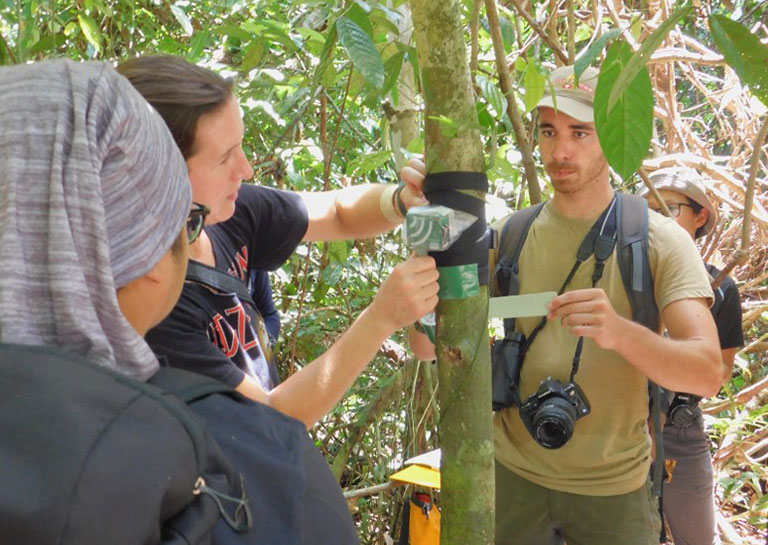
Sheridan and students attach AudioMoth recorders, provided by Justin Kitzes at the University of Pittsburgh, to test how well recorders detect amphibian diversity. Photo: Sahat Ratmuangkhwang
“Frogs are great connectors in tropical ecosystems,” says Robert Ewers, an ecologist at Imperial College London and science director for the SAFE Project. “They link the mini-world that exists inside small streams with the terrestrial world that surrounds them.”
With any luck, Ewers, Sheridan, and the rest of the SAFE team will find strategies that can help stem the loss of biodiversity caused by palm oil production, not unlike how some fisheries have evolved to catch fewer endangered species.
“I hope that the palm oil companies will pay attention to the data and that they will ultimately incorporate some of these suggestions into future plantation design,” Sheridan says. “I’m cautiously optimistic.”
Indiana Jen
Whether it’s deforestation, disease, or more localized issues, Sheridan wants to get younger students involved in the conservation of animals. Before moving to Pittsburgh this past summer, she spent four years as an assistant professor with Yale-NUS College in Singapore where she routinely took students out into the jungle to conduct experiments and hone their fieldwork skills.
“It’s important for me to keep providing these kinds of experiences because I know from my own experience how transformative they can be,” says Sheridan.
A collaboration with undergraduate Yeo Zhi Yi ended in a publication this February on the impact traffic noise can have on tree frogs. Even in remote areas, Yeo and Sheridan found that frogs started to call louder when in the presence of noise pollution, which could negatively affect the overall fitness of the animals.
“This was my first time publishing scientific research,” says Yeo, who is from Singapore but had never visited a rainforest before taking Sheridan’s class. “Professor Sheridan has definitely heightened my interest in the sciences and made me think more seriously about doing a PhD and possibly going into academia. She has also set a very high bar as a researcher for me to look up to and work towards.”
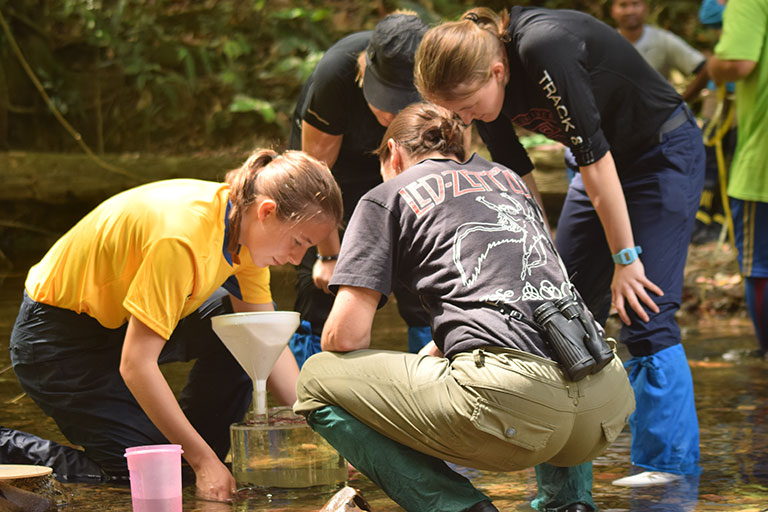
Sheridan and students set up an aquatic primary productivity measurement. Photo Kevin Wallace
“Jen is someone who really showed me that this is a path I could take as a female in herpetology.”
– Sarah McGrath, conservation researcher and biology instructor at James Madison University
Sarah McGrath, who now teaches biology at James Madison University, said the season she spent working for Sheridan as a field assistant in Borneo was a turning point in her career. Herpetology is a field that tends to be dominated by men, and yet here was Sheridan haggling with shopkeepers in Malay, loading up the truck with field provisions, and then driving through the night along dusty, washed- out roads.
“After seeing Jen and all that she did, working as a woman in a foreign country, I really felt validated that I could do this kind of research, too,” says McGrath. “Jen is someone who really showed me that this is a path I could take as a female in herpetology.”
While traveling abroad for her research, Sheridan is quick to point out that you don’t have to go all the way to Malaysia to fall in love with frogs.
This summer, she’ll work with an undergraduate student to take stock of Pennsylvania’s native amphibian species, starting with the hoppers found at Powdermill Nature Reserve, Carnegie Museum of Natural History’s research station in the Laurel Highlands. She’s also met with teachers at Pittsburgh’s City Charter High School to find new ways to expose teens to the science of the natural world at an earlier age. She hopes classroom visits, programs at the museum, and maybe even field trips to local nature areas like Schenley Park could set kids on a path toward science.
“A lot of people tend to think nature is out there somewhere, and not here where we live,” says Sheridan.
In the end, she notes, it’s all about providing students with that “aha” moment—an opportunity to experience a toad breathing inside your palm, or to bathe in the sound of a dark forest full of spring peepers.
“It’s crucial to foster these experiences for that next generation,” says Sheridan. “Obviously, I want everyone to choose science.”
Receive more stories in your email
Sign upTags:
Science & Nature
